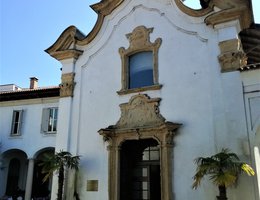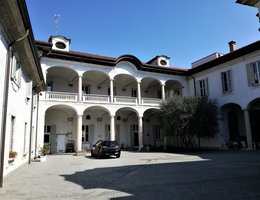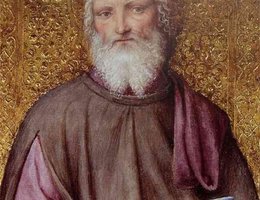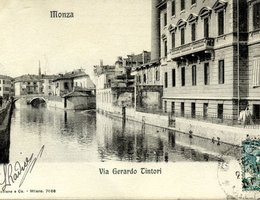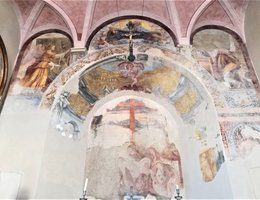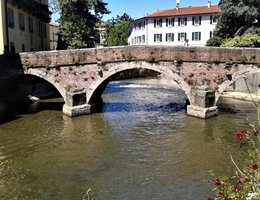di Longoni Corinna e Cappella Arianna
Monza, 1174. Gerardo Tinctor – chiamato così perché proveniente da una famiglia legata all’attività della tintura dei panni di lana – impiega l’eredità paterna per la cura dei poveri e dei malati: lo storico Bonincontro Morigia scrive che “ancora giovanetto, dopo la morte del padre, si dà all’ospitalità dei poveri”. Nasce così, presso la casa paterna, l’“Ospedale Sant’Ambrogio”, anche chiamato “Ospedale dei poveri”, che diventa “Ospedale di San Gerardino” nel 1213. Sebbene la fondazione di ospedali in quest’epoca fosse solitamente affidata all’opera di religiosi, Gerardo crea una regola laica – essendo lui tale – lavorando come privato e accogliendo qualsiasi malato.
Gerardo, nel desiderio di proseguire la sua opera umanitaria anche dopo la sua morte (avvenuta il 6 giugno 1207), stipula un accordo con l’arciprete e i consoli del comune di Monza circa la costruzione di una struttura. Lui stesso si carica dei compiti di fatica: portare in spalla i malati trovati in giro, lavarli, nutrirli e servirli. Invece, affida le altre funzioni a sei decani del popolo assistiti ed eletti dai frati conversi con l’approvazione dell’arciprete e dei consoli del comune, e soggetti all’impegno del celibato; successivamente, nel XIII secolo, anche le sorores conversae entrano a far parte dell’amministrazione dell’Ospedale. La struttura non opera soltanto come nosocomio, che comunque ne costituisce il ruolo principale, ma anche come orfanotrofio, ospizio per i poveri e casa di lavoro. Intorno alla metà del XIV secolo, vengono inseriti un cappellano per la celebrazione della Messa bisettimanalmente, un prete per la guida e un funzionario per la distribuzione delle diete.
Il 26 novembre 1458, Papa Pio II emana una bolla con cui approva la costruzione dell’Ospedale maggiore di Milano. L’Ospedale di San Gerardino continua comunque la propria attività ospedaliera e di elemosina fino al 1769, quando vengono soppresse tutte le opere pie di Monza e territorio limitrofo che confluiscono in un unico ente. Nel 1831, viene trasferito in quello che era il seminario e viene fondato il nuovo ospedale in via Solferino intitolato ad Umberto I, diventando “Ospedale San Gerardo” nel 1946 per poi trasferirsi negli anni ’70 in quella che è anche la sua attuale ubicazione in Via Pergolesi. A partire dal 2004 la primitiva sede di Via Gerardo dei Tintori 18 è stata riaperta e integra 29 alloggi protetti per anziani autonomi che iniziano ad avere delle fragilità a vivere da soli in un appartamento.
Grazie alla sua forte dedizione completa e alla sua cura verso gli altri, Gerardo Tinctor viene chiamato “beato” in un documento datato 1230 e “santo” in uno del 1247, e molti sono i pellegrinaggi verso la sua tomba. Inizialmente collocato in una fossa comune nel cimitero di Monza, il suo corpo viene poi trasferito nella Chiesa di Sant’Ambrogio, oggi chiamata Chiesa di San Gerardo al Corpo proprio in onore del Santo.
La canonizzazione ufficiale arriva, però, tempo dopo, nel 1583, con la richiesta di San Carlo Borromeo a papa Gregorio XIII che fa compiere un’inchiesta a riguardo. Egli, infatti, si rese protagonista di diversi miracoli: si racconta che riempisse miracolosamente le dispense di viveri e la cantina di vino. Ancora, si crede che abbia disteso sulle acque del Lambro il suo mantello, bloccando la piena del fiume e salvando, così, l’ospedale dall’inondazione; un tempo, infatti, la casa del santo era collocata in un quartiere caratterizzato dalla presenza di canali e mulini ed era, quindi, raggiungibile attraverso una passerella, oggi sostituita con un ponte in pietra. Inoltre, a lui sono attribuiti altri prodigi uniti a un che di mitico: nel clima teso della Lombardia dominata da Federico Barbarossa, Gerardo ottiene dai sacrestani di poter pregare nella basilica di San Giovanni Battista (Duomo di Monza) tutta la notte e, come ricompensa di ciò, li omaggia di un cestino colmo di ciliegie, nonostante la vicenda si svolse a dicembre. A ricordo di queste vicende, tra i vari simboli che accompagnano la sua figura nelle rappresentazioni vi sono saio, mantello e ciliegie; un dipinto fu effettuato anche da Bernardino Luini nella basilica di San Giovanni Battista, il luogo dove San Gerardo trascorse la notte per pregare. Oggi è uno dei patroni di Monza ed è considerato “padre della patria” in seguito alla costruzione di un monumento a lui dedicato risalente al XVII secolo.
Per quanto riguarda la chiesetta dedicata al Santo collocata all’interno dell’Oasi San Gerardo, le prime notizie circa la sua esistenza risalgono a un documento del 1352. Presenta una facciata in stile rococò (fine ‘700), sebbene i parametri murari e i principali elementi strutturali risalgano al ‘400-‘500, così come gli affreschi absidali. Alla chiesa originaria, che oggi costituisce il braccio destro del transetto, fu annessa un’abside.
All’interno della chiesa è conservato un affresco cinquecentesco realizzato da Bernardino Luini e rappresentante l’Annunciazione, sormontato da altri tre dipinti. Al centro angeli e cherubini circondano la figura di Dio raffigurato a mezzo busto e a braccia aperte; a sinistra e a destra, invece, appaiono rispettivamente l’arcangelo Gabriele – riconoscibile grazie al simbolo del giglio – e Maria avvicinata dalla colomba dello Spirito Santo. Anche se oggi non sono più visibili, sotto gli affreschi laterali vi erano due affreschi raffiguranti scene della vita di San Gerardo – la traversata del Lambro e probabilmente la guarigione DEGLI OLGIATESI (???????). Inoltre, sempre collocati ai lati erano due affreschi ritraenti due santi: sulla sinistra San Rocco, protettore degli appestati, e sulla destra San Sebastiano. La paternità della scena centrale, illustrante una Deposizione, non è da attribuire a Bernardino Luini ma a un pittore tutt’oggi sconosciuto.
ENGLISH VERSION
In 1174, Gerardo Tinctor, who gets his name from his father’s dying activity – “to dye” in the Italian language is “tingere” – used the inheritance acquired from his father to help poor and infirm people in the city of Monza. At his time, the administration of hospitals for the poor was traditionally in the hands of the clergy. Even though he was not a cleric, he used his own house to host people in need. The institution’s name was “Hospital of Saint Ambrose”, or “Hospital for the Poor”, that changed its name in “Hospital of San Geradino” in 1213. Today it no longer exists, since it was closed in 1769. In the late 19th century, another institution adopted his name: the “Hospital of San Gerardo” was built and it currently is the main hospital in Monza. However, starting from 2004, the original Hospital of San Gerardino was reopened and today it functions as an accommodation for elderly people.
Since Gerardo wanted his activity to continue after his death, he signed an agreement with the archpriest and consuls of the community of Monza for the construction of a building. He himself helped the poor by feeding and serving them. The building functioned not only as a hospital but as an orphanage and a hospice as well; in the middle of the 14th century, it was also used to celebrate the Mass.
In the 14th century, a little church was built near San Gerardo’s house. Even though the structure belongs to the 1300’s, the façade shows a rococo style, typical of the 18th century; later, an apse was added. Bernardino Luini painted a large fresco that represents the Annunciation; upon this are three other paintings. The central one depicts God surrounded by angels and cherubs, while the lateral ones represent respectively the archangel Gabriel with a lily – his symbol – and Mary reached by the Dove of the Holy Spirit. Also, below these paintings there were two frescos representing scenes related to the life of Saint Gerardo, in particular the crossing of the Lambro River and the healing of an ill man; however, they are not visible today. And the same can be said for two other frescoes, depicting Saint Roch, the patron of ill people, and Saint Sebastian. There is also another painting situated in the center and representing the Burial of Jesus, but the painter remains unknown.
A 13th century notary deed describes Gerardo as a “beatified person” and another document presents him as a “saint,” but, in actual fact, he was canonized only in 1583. Indeed, Pope Gregory XIII certified that he had performed various miracles. The first miracle that comes to mind thinking about San Gerardo is that he once filled up a pantry with food and a cellar with wine, when food and wine were not enough. On another occasion, by laying out his mantle on the water of Lambro River, he stopped the river flood that would have otherwise destroyed the Hospital. Furthermore, he is the protagonist of another miracle: when Lombardy was dominated by Fredrick I Barbarossa, he got to stay in the church of Saint John in Monza at night and pray. To thank the sextons that allowed him to spend the night there, he gave them a basket full of cherries – even though it was December. Recalling his miracles, he is often depicted wearing a tunic and a cloak and holding a basket full of cherries; a fresco representing the Saint is painted in the church where he prayed that night of December.
Today he is one of the patrons of the city of Monza and he is regarded as “father of the Nation”. In his honor, a 17th century monument was built. He is definitely someone to look up to: a man who, coming from a well-off family, decided to be unselfish and to invest his inheritance in the help of the poor. For this reason, he is celebrated in Monza every year on June 6th, the day of his death that occurred in 1207. His corpse was initially buried in Monza’s cemetery but was later brought to the Church of San Gerardo al Corpo that takes its name from the Saint himself.
BIBLIOGRAFIA
